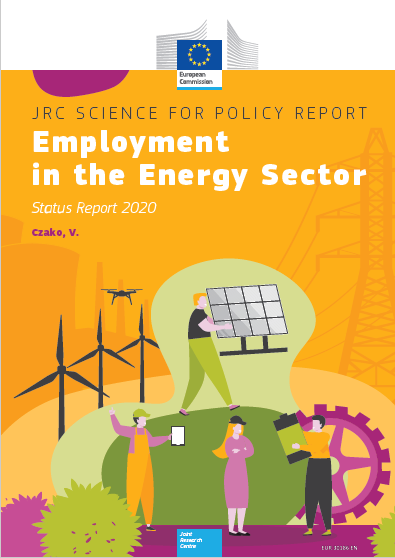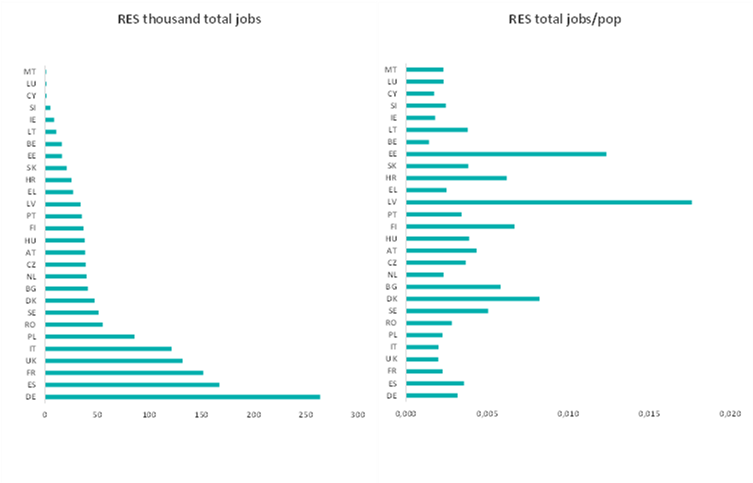
The ongoing transition towards a green economy and a low-carbon energy system has profound societal implications both worldwide and in the EU. The road towards recovery from the COVID-19 pandemic puts this green transition in a new light: the immediate need to revive economic growth and employment can be seen as a potential vehicle to create jobs in clean technologies, as part of long-term sustainable investment plans.
A well-designed transition to a climate neutral economy may help make labour markets more resilient to the damaging effects of globalisation, technological change, resource scarcity and demographic changes. In order to achieve this in an effective and inclusive way, however, tasks such as reskilling the workforce in declining sectors and addressing its gender imbalance must be addressed.
In 2018, the JRC carried out an assessment of opportunities and challenges facing European coal regions in the context of the clean energy transition, estimating employment effects. Now, the results of a JRC study focused on the green transition’s impact on jobs in the whole energy sector have been published. The report, titled Employment in the Energy Sector - Status Report 2020 , presents a synthesis of the latest available data on the employment impacts of the clean-energy transition at the global and EU level. It also discusses qualitative aspects such as education, skills requirements and workforce characteristics.
Nearly 58 million people worldwide were employed in the energy sector in 2017. Although about half of these jobs were in the fossil fuel industries, renewable energy employment is increasing globally, reaching 11 million total jobs in 2018. Photovoltaics, bioenergy and hydropower account for 80 % of global renewable energy jobs. China is the largest employer in the sector, accounting for 37 % of total renewable-energy jobs in the world. Sectors benefiting in terms of employment from the green transition include construction, electrical machinery manufacturing, mining of critical metals, renewable energy production, biomass crop cultivation, transport and services. Employment in the broad energy sector (comprising fossil fuels and renewables sectors, as well as energy flexibility and grid development) is expected to reach 87 to 100 million total jobs by 2050, depending on the ambition of decarbonisation policies.
As for the EU, its renewables sector accounted for over 1.5 million jobs in 2018. Despite the ever-growing share of renewable energy, a downward trend in related jobs occurred from 2011 onwards, turning to stagnation in the following years. Factors behind this development include the aftermath of the 2008 financial crisis, the relocation of some renewables manufacturing capacities outside of Europe, and changes in subsidy schemes for renewables within the EU. The solid biomass and wind sectors each supported nearly a quarter of total EU renewable-energy jobs, with liquid biofuels, heat pumps, photovoltaics and hydropower following. Over half of these jobs were located in Germany, Spain, France, the United Kingdom and Italy; in terms of renewable-energy jobs per capita population, Latvia, Estonia, Denmark and Finland are in the lead in Europe.
Implementing the Paris Agreement, in full worldwide, which would limit global warming to 2°C by the end of the century, could create 18 million net additional jobs by 2030 due to changes in the production and use of energy. The outbreak of the COVID-19 coronavirus crisis in early 2020 gives these findings a new perspective, since accelerating the green transition could help the economic and social recovery. In the EU, the green transition was expected to create 1.2 million additional jobs before the outbreak of COVID-19.
The workforce in the energy industry, in general, is male dominated and is aging. However, women are better represented in the renewables industries (32 % of the workforce worldwide) than in conventional energy sectors (22 %). In the EU, women’s representation across all economic activities is 46 %, but only 25 % in ‘electricity, gas, steam and air conditioning supply’ and even lower in extractive fossil fuel industries and the construction of buildings.
As for younger people, they are underrepresented in the energy sector but are characterized by higher willingness to participate in upskilling and reskilling programmes. The latter is an important factor in the successful transition of regions from fossil fuels and energy intensive industries towards a greener economy. Science, technology, engineering, and mathematics profiles as well as digital skills are in high demand in the energy industry as a whole. An increase in demand for more multidisciplinary knowledge is also likely in the context of new business models and societal initiatives. Further research is foreseen on education and skills requirements, as well as changing talent profiles, in the context of the ongoing green economic and clean energy transition.

Employment in the EU-28 by Member State and RES employment per population, 2018 (Source: JRC 2020 based on (EurObserv’ER, 2019) and Eurostat (TPS00001))
Related Content
Details
- Publication date
- 9 July 2020
